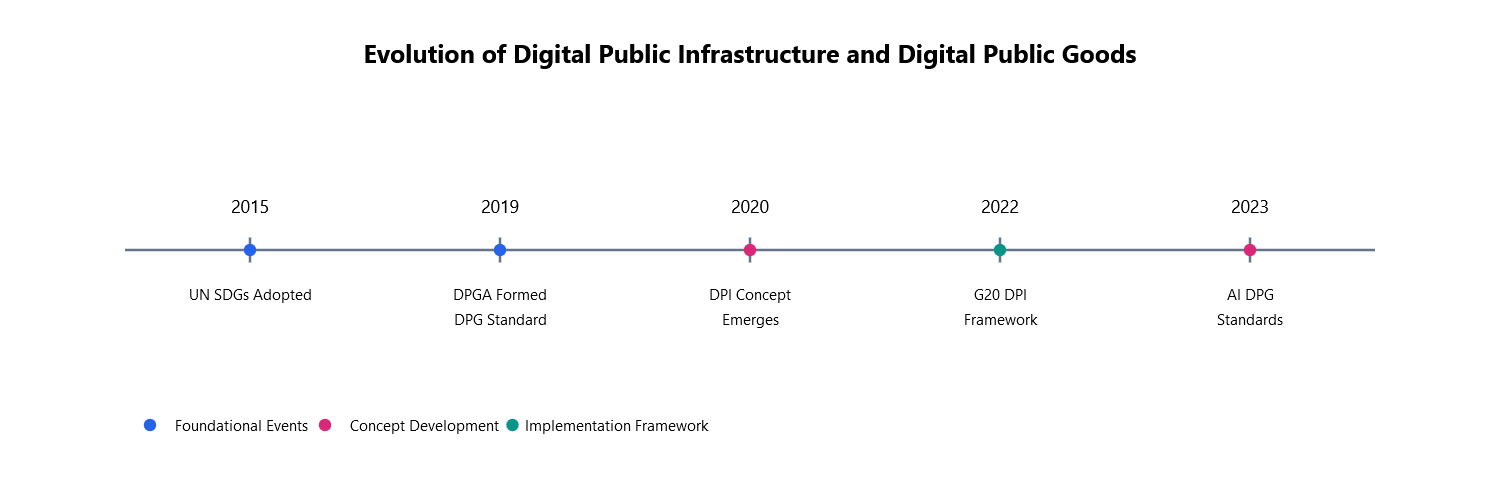As governments worldwide accelerate their digital transformation efforts, the intersection of Artificial Intelligence (AI) and Digital Public Goods (DPGs) emerges as a crucial catalyst for developing robust Digital Public Infrastructure (DPI). This evolution represents a significant shift in how public services are conceived, delivered, and maintained, promising to enhance efficiency, accessibility, and inclusivity of government services.
The concepts of Digital Public Infrastructure (DPI) and Digital Public Goods (DPGs) have emerged as crucial elements in the global digital transformation landscape. These frameworks represent a significant shift in how we approach digital development and public service delivery.
Digital Public Goods were first conceptualized in alignment with the United Nations Sustainable Development Goals (SDGs) adopted in 2015. The Digital Public Goods Alliance (DPGA), established in 2019 as a multi-stakeholder initiative by Norway, Sierra Leone, and UNICEF, serves as the primary governing body for DPGs. They developed the DPG Standard, which provides a comprehensive framework for evaluating and certifying digital solutions as public goods.
Digital Public Infrastructure emerged as a concept around 2020, particularly gaining prominence through India’s successful implementation of the India Stack. The G20 Digital Economy Working Group has since become a key forum for DPI development, establishing frameworks and guidelines for national implementation.
Digital Public Infrastructure forms the backbone of modern government services, enabling essential functions like digital identity verification, payment systems, and data exchange. The integration of AI-powered Digital Public Goods into this infrastructure marks a new frontier in public service delivery, offering unprecedented opportunities for automation, personalization, and optimization.
Digital Public Infrastructure refers to foundational digital systems and services that enable basic societal functions. These include digital identity systems, payment platforms, data exchanges, and other digital tools that support governance, commerce, and citizen engagement. DPI is designed to be interoperable, scalable, and inclusive, enabling access to essential services and economic opportunities.
Global DPI Governance Ecosystem
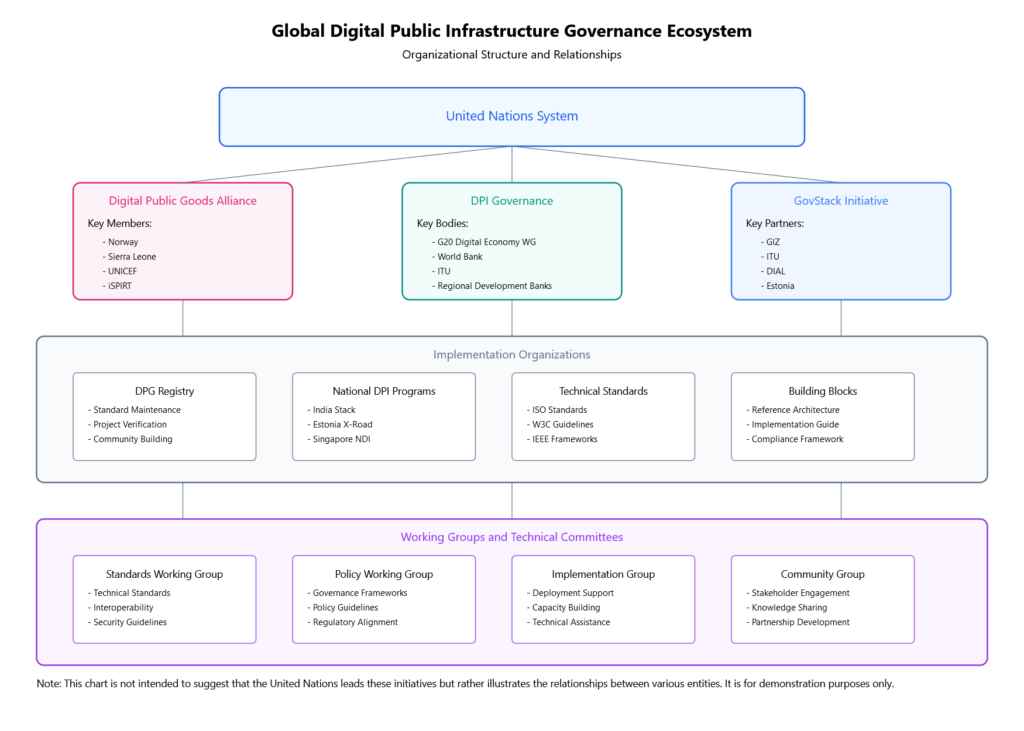
The Global Digital Public Infrastructure Governance Ecosystem chart illustrates the organizational structure and relationships between various entities involved in Digital Public Goods, Digital Public Infrastructure, and the GovStack initiative. It represents a collaborative effort to establish governance frameworks and implementation mechanisms that support digital transformation on a global scale.
The governance structure is anchored by three primary pillars. The Digital Public Goods Alliance plays a central role in overseeing the development and governance of Digital Public Goods. It ensures that DPGs adhere to global standards of openness, accessibility, and usability. The alliance, founded by Norway, Sierra Leone, and UNICEF, includes key members such as iSPIRT and focuses on maintaining the DPG Standard, managing the DPG Registry, and fostering a vibrant community to support the adoption and scaling of DPGs.
The second pillar, DPI Governance, is shaped by the collaborative efforts of the G20 Digital Economy Working Group, the World Bank, ITU, and Regional Development Banks. This framework supports the coordination of national Digital Public Infrastructure initiatives and fosters international cooperation and standardization to ensure that infrastructure projects align with global priorities.
The GovStack Initiative constitutes the third pillar, representing a joint effort among organizations like GIZ, ITU, DIAL, and Estonia. Estonia plays a significant role by sharing its expertise in e-governance. GovStack focuses on creating reusable digital building blocks that governments can use to streamline service delivery, emphasizing scalability and interoperability.
Implementation structures operate within these governance pillars to translate high-level frameworks into actionable programs. The DPG Registry oversees the certification process for DPGs and facilitates community building by maintaining and verifying projects against global standards. National DPI Programs demonstrate practical applications of these frameworks at the country level, with examples like India Stack, Bangladesh A2i (X-Road version), and Kyrgyzstan’s ELQR showcasing their potential for scalability. Technical Standards bodies, including ISO, W3C, and IEEE, ensure the quality and interoperability of these implementations through the development and maintenance of global standards. The building block approach, championed by GovStack, provides reference architectures and implementation guides to help governments design and execute digital services effectively.
Working Groups and Technical Committees span these implementation structures, providing specialized support and oversight. The Standards Working Group focuses on technical specifications and interoperability requirements. The Policy Working Group develops governance frameworks and regulatory guidelines. The Implementation Group provides hands-on support for deployment and capacity building, while the Community Group engages stakeholders and facilitates knowledge sharing to encourage collaboration and mutual learning.
This interconnected governance ecosystem ensures clear hierarchies, fosters collaboration across diverse entities, provides practical pathways for implementation, and supports the continuous development of standards and best practices. The relationships visualized in the chart reflect a commitment to building a coordinated and sustainable approach to digital public infrastructure and goods on a global scale.
AI DPGs as Boosters for DPI Development
Digital Public Goods are transforming how Digital Public Infrastructure operates and scales. This transformation occurs through several key mechanisms:
Enhanced Functionality: AI DPGs augment existing infrastructure with advanced capabilities:
- Automated processing of complex documents
- Real-time language translation services
- Predictive maintenance of systems
- Intelligent resource allocation
For example, Estonia’s X-Road platform has integrated AI capabilities to improve service delivery and security, demonstrating how AI can enhance existing DPI (A tool for identifying data exchange anomalies of the X-Road).
Adaptive Scaling AI enables infrastructure to scale not just in size but in complexity. The MOSIP digital identity platform demonstrates this by using AI to handle biometric verification across diverse populations while maintaining high accuracy and security standards. The system learns and adapts to different contexts, making it more effective as it scales.
Scalability Improvements: AI DPGs enable infrastructure to handle increasing demands:
- Dynamic resource allocation
- Automated load balancing
- Predictive capacity planning
- Intelligent traffic management
India’s Unified Payment Interface (UPI) system exemplifies this through AI-powered fraud detection and transaction processing, handling billions of transactions monthly. As more AI DPGs are integrated into existing infrastructure, they create positive feedback loops. When healthcare systems share anonymized data through AI-powered platforms like OpenSAFELY, the collective knowledge improves diagnosis accuracy across the entire network.
Cost Efficiency: AI DPGs lead to reductions of operational costs while keeping quality of service:
The NHS AI Lab in the UK has shown how AI-powered systems can optimize healthcare delivery, reducing waiting times and improving diagnostic accuracy while maintaining cost-effectiveness.
This exemplifies how AI can transform static infrastructure into dynamic, responsive systems.
Guiding deployment of AI DPGs responsibly
The evolution of AI technologies and disputes around open source and proprietary AI Systems forced the development of additional standards to the Digital Public Goods to reflect these considerations in the future standards. In 2023, A convened Community of Practice, consisting of industry experts, had been drafting recommendations on updating the DPG Standard. The objective was to determine how best to assess AI systems for DPG recognition. Based on the recommendations, the DPGA secretariat published proposal on “Defining Mandatory Components for AI Systems Seeking Digital Public Good (DPG) Recognition” on November 6, 2024.

Specifically, the DPGA set the following qualification requirements for opens source AI systems:
- Data
- Datasets – the dataset(s) used to train the system should be open under conformant licenses to the Open Definition.
- Code
- Data pre-processing – available under OSI-approved license.
- Training, validation, and testing – available under OSI-approved license.
- Inference – available under OSI-approved license.
- Supporting libraries and tools – available under OSI-approved license.
- Model
- Model architecture – the type of model, layers, and structure should be available under an OSI-approved license.
- Model parameters – weights, optimizers, coefficients, and other applicable hyperparameters should be available under OSD-conformant terms (this could include OSI-approved licenses or terms and conditions).
These components are based on the Model Openness Framework (MOF) and Open Source AI Definition Checklist to evaluate machine learning systems. Other components listed in these frameworks, such as research papers, evaluation results, sample model outputs, among others are optional unless specified in other indicators of the DPG Standard.
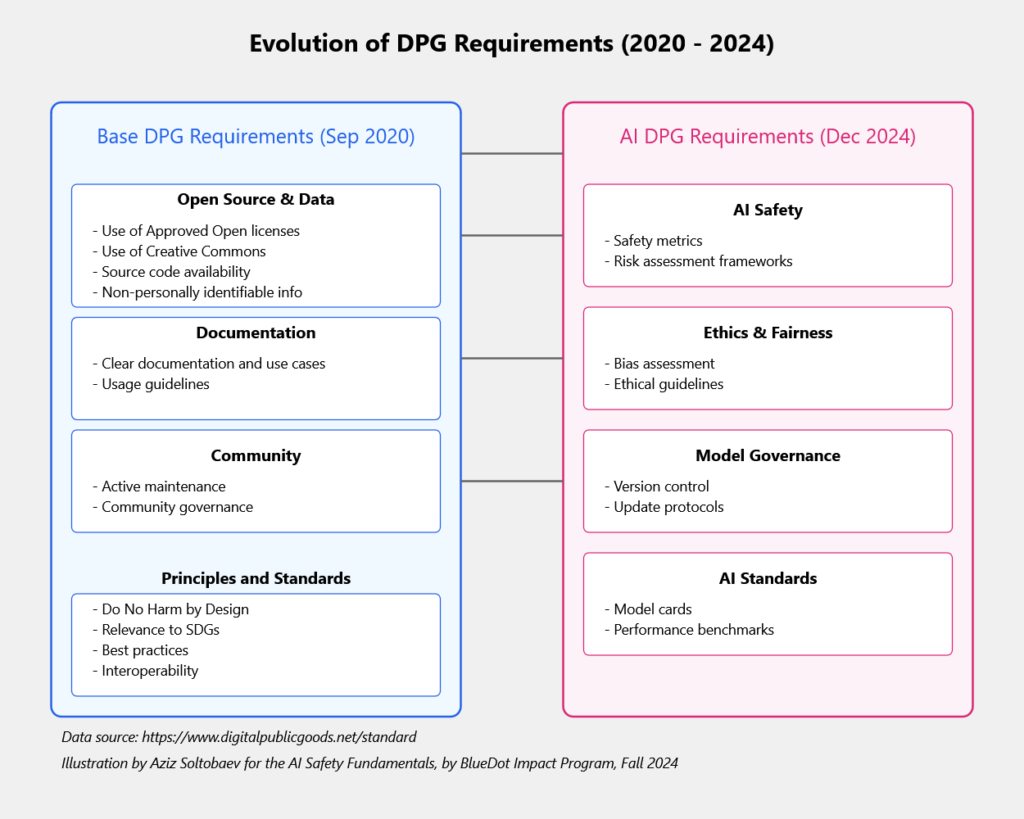
Chart: Evolution of DPG Requirements (2020-2024)
The DPGA made references and interlinkage of its qualification requirements with the standards established by the Open Source Foundation. For the purposes of the OSI requirements had been charted to demonstrate amendments in one illustration. Specifically, the OSI requirements cover issues related to the AI Safety, Ethics and Fairness, Model Governance and model cards standards.
Based on the DPGA registry list I’ve tried to visualize existing DPGs that might fit into the current proposal on mandatory components for AI Systems seeking DPG recognition.
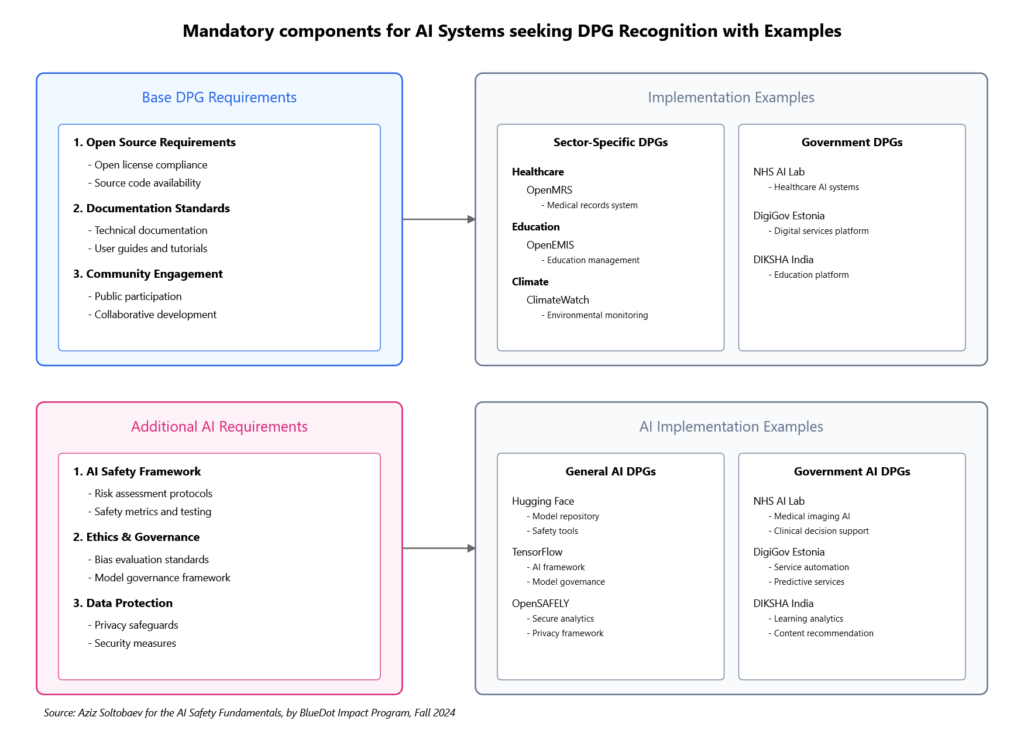
Illustration: Mandatory components for AI Systems seeking DPG Recognition
The NHS AI Lab represents a significant advancement in healthcare AI implementation. Founded in 2019 by NHS England with an initial investment of £250 million, it focuses on accelerating the safe adoption of AI in healthcare settings. The Lab develops and deploys AI solutions across the UK’s National Health Service, which serves 55 million patients and employs 1.2 million staff. Their work includes developing standardized approaches to AI safety in clinical settings, creating frameworks for responsible AI deployment, and ensuring equitable access to AI-powered healthcare innovations.
India’s DIKSHA (Digital Infrastructure for Knowledge Sharing) platform, established in 2017 by the National Council of Educational Research and Training, represents one of the world’s largest educational technology implementations. The platform serves over 200 million users across 35 languages, delivering more than 1 billion learning sessions annually. Their AI systems focus on personalized learning paths, content recommendations, and learning analytics to support both students and teachers across India’s diverse educational landscape.
Estonia’s DigiGov initiative, launched in 2014 as part of the broader e-Estonia movement, demonstrates how AI can transform public service delivery. The program has achieved remarkable success, with 99% of government services now available online. The system serves as a model for digital governance, saving approximately 2% of GDP annually through improved efficiency. Their AI implementation focuses on predictive service delivery, where the system anticipates citizens’ needs based on life events and automatically suggests or initiates relevant services.
Although these cases represent good representation of the DPG usage, it’s worth noting that the OSAID as part of the validation and testing had qualified only a few AI systems to be considered as open. That creates potential concerns on the number of potential governmental solutions that could be expected to be recognized as DPGs.
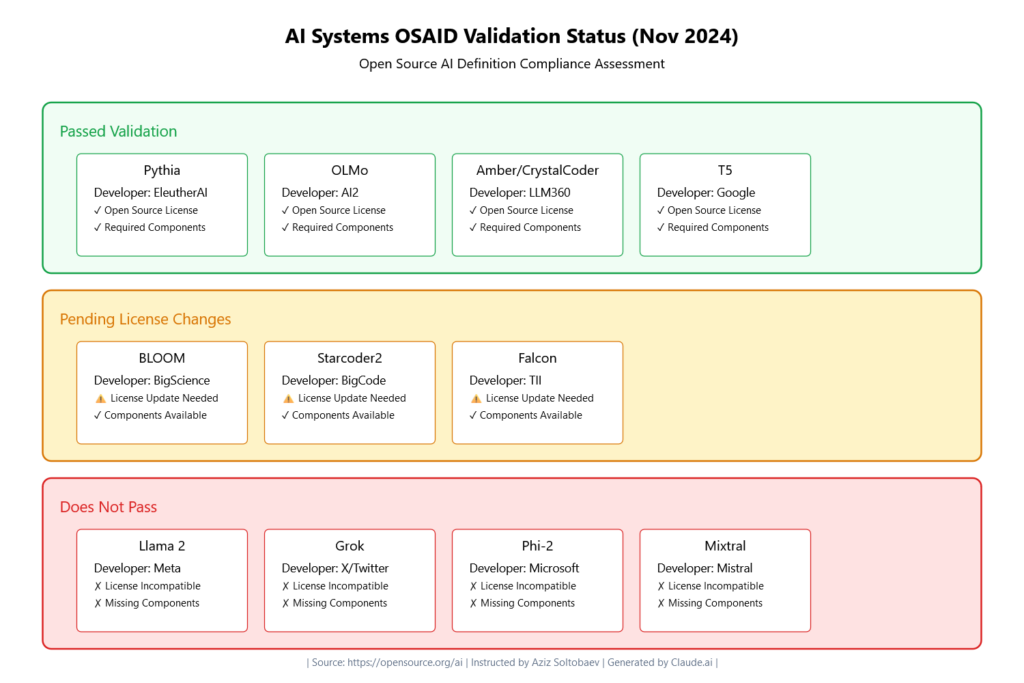
Illustration: AI Systems OSAID Validation Status.
Validated AI Models: Current Foundation for AI DPGs:
- Pythia (EleutherAI) Pythia represents a family of open-source language models developed with transparent training procedures. What makes Pythia particularly valuable as a DPG is its systematic approach to model development. The team trained multiple models of various sizes under identical conditions, providing invaluable insights into how neural networks learn and scale. This transparency helps researchers and developers understand AI system behavior, making it easier to build safe and reliable applications for public services.
- OLMo (AI2) The Open Language Model (OLMo) from the Allen Institute for AI stands out for its commitment to complete transparency. Every aspect of OLMo’s development, from data collection to training decisions, is publicly documented. This thoroughness in documentation sets a high standard for AI DPGs, particularly in areas requiring high trust and accountability. OLMo’s approach demonstrates how to build AI systems that can be thoroughly audited and understood by the communities they serve.
- Amber and CrystalCoder (LLM360) These models from LLM360 showcase how collaborative, community-driven development can work in practice. Their development process emphasizes reproducibility and open collaboration, with all training data, code, and model weights freely available. This approach proves particularly valuable for government agencies and educational institutions looking to build customized AI solutions while maintaining full control and understanding of their systems.
- T5 (Google) Google’s T5 model, while developed by a large corporation, meets DPG requirements through its open-source nature and comprehensive documentation. Its text-to-text framework provides a versatile foundation for various language tasks, making it particularly valuable for public sector applications requiring multiple language processing capabilities.
The intersection of AI with Digital Public Goods and Digital Public Infrastructure represents a pivotal moment in digital governance. Based on the qualified open AI Systems governments and companies could build such AI DPGs as:
- Diagnostic Assistant DPG: Building on models like OLMo, this system could help healthcare workers in resource-constrained settings make more informed decisions. The key would be developing it with extensive medical knowledge while maintaining privacy and security standards.
- Multilingual Educational Content: Building on T5’s architecture to develop systems that can make educational resources available in multiple languages, promoting educational equity.
- Policy Analysis Tool: Creating AI systems that can analyze the potential impacts of policy decisions on different community segments.
DPGA Secretariat Proposal undertakes the first steps on setting and reviewing standards based on the community feedback and further practical adoption. Therefore the process of the working group would be agile and evolving over time changing approach and standards that would lead to the change of number of potential open ai systems eligible to be qualified for digital public good.
Conclusion
The integration of Artificial Intelligence (AI) within Digital Public Goods (DPGs) marks a turning point in the evolution of Digital Public Infrastructure (DPI), promising transformative benefits for society. By integrating AI capabilities into DPGs, governments can unlock unprecedented efficiencies, inclusivity, and personalization in public service delivery. As evidenced by pioneering initiatives such as India’s DIKSHA, Estonia’s DigiGov, and the NHS AI Lab, AI-powered solutions are not merely enhancing existing infrastructure but are setting new benchmarks for scalability, adaptability, and cost-effectiveness.
However, this evolution is not without its challenges. The need for robust governance frameworks, ethical standards, and transparency in AI development underscores the importance of initiatives like the DPGA’s updated qualification requirements for AI systems.
These frameworks ensure that AI DPGs remain open, secure, and aligned with global standards, fostering trust and equity in their deployment.
The frameworks proposed by the DPGA) and ongoing initiatives illustrate how responsible AI can enhance public services while safeguarding ethical standards. These examples underscore the critical role of open, transparent, and inclusive AI systems in fostering trust, safeguarding rights, and ensuring equitable access to digital innovations.
The path forward demands a collaborative approach, bringing together stakeholders across governments, academia, industry, and civil society to shape an inclusive and sustainable digital future. By leveraging AI DPGs responsibly, we can transform DPIs into engines of innovation and resilience, capable of addressing complex societal challenges while advancing the United Nations Sustainable Development Goals.
In this pivotal moment, the commitment to transparency, openness, and ethical AI is not just a choice but a necessity. As nations continue to navigate the opportunities and complexities of AI and digital transformation, the lessons and frameworks established today will serve as the foundation for a more equitable and prosperous digital society tomorrow.
This post had been crossposted from the KG Labs Public Foundation website https://kglabs.org/digital-public-infrastructure/ai-digital-public-goods-securing-responsible-digital-public-infrastructure-development-explainer/

Aziz Soltobaev is multifacted professional at the intersection of technology, policy and artificial intelligence. With a rich background on digital policy and research, Aziz has established himself as a prominent figure in the field of advanced technologies, contributing significantly to various initiatives aimed at shaping responsible AI governance and deployment.
As a Fellow of the Stimson Center and the Microsoft Responsible AI Program, Aziz has delved deep into the complexities of AI ethics, governance, and regulation. The Fellowship Program examined AI applications and evaluate their impacts in developing countries. Together with other fellows, the program seeked to understand how AI-related harms and benefits may manifest themselves in various social, cultural, economic and environmental contexts, and identify technological as well as regulatory solutions that might help mitigate risks and maximize opportunities (2023-2024).
Aziz had successfully passed AI Policy fundamental certification program organized by the Center for Artificial Intelligence and Digital Policy (USA). The certification program is a semester-long AI policy and regulation training, provided to AI policy practitioners, policymakers, lawyers, academics and civil society members. The participants learn about AI policy research, analysis, and main AI policy frameworks around the world (OECD, G20, UNESCO, EU AIA, Blueprint for AI Bill of Rights, Council of Europe, African Resolution on Human Rights, etc). The certification program is an outgrowth of the work of the Research Group, and includes requirements for research, writing, and policy analysis. Receipt of the CAIDP AI Policy Certification requires completion of a detailed multi-part test. The subjects are: AI History, AI Issues and Institutions, AI Regulation, and Research Methods. Aziz obtained Certificate with distinction and signed Statement of Professional Ethics for AI Policy.
As a fellow of the Atlantic Council Artificial Intelligence Connect Program, Aziz had a privilege on learning about opportunities and challenges in responsibly developing and deploying AI technologies across sectors in line with human-centric values in the OECD AI Principles. As a part of in-regional workshops and site visits, Aziz had examines case studies and best practices, strenghtened connections with distinguished AI policy experts and professionals from different parts of the world.
His research endeavors extend beyond theoretical frameworks to practical applications, particularly in the context of Central Asia. Aziz contributed to the review of the Kazakhstan’s National AI Policy and representation of the country in the Artificial Intelligence and Democractic Values Report issued by the CAIDP in 2023.
In addition to his contributions to national policy frameworks, Aziz has conducted thorough assessments of Kyrgyzstan’s AI landscape, offering valuable insights and recommendations through his overview of the country’s National AI Policy for the Global Index on Responsible AI (GIRAI) in 2024. The Global Index is designed to equip governments, civil society, and stakeholders with the evidence needed to advance rights-based principles for the responsible use of AI.
Aziz’s interests extend beyond conventional AI paradigms, encompassing emerging technologies such as small language models like Phi-2 and the field of TinyML. His forward-thinking approach reflects a keen awareness of the evolving AI landscape and a commitment to exploring innovative avenues for harnessing AI’s potential for the benefit of humanity.
With a wealth of experience and a passion for leveraging AI for positive societal impact, Aziz Soltobaev continues to be a driving force in shaping the responsible and equitable deployment of artificial intelligence on both national and global scales.
Aziz is cofounder and Programs manager at the Internet Society Kyrgyz Chapter, Founder and Chair at the KG Labs Public Foundation

